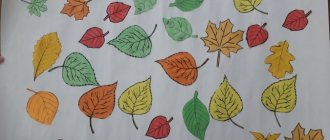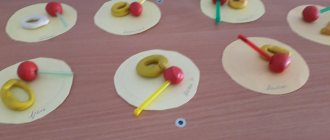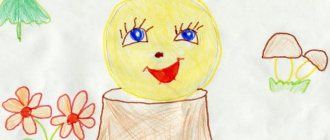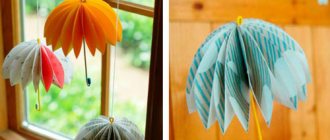On the topic: methodological developments, presentations and notes
The lesson allows you to expand and clarify children’s ideas about toys, their purpose, essential features (color, shape, size), and carry out correctional and developmental work with children aimed at n.
Our children are constantly under enormous psycho-emotional and spiritual pressure - in kindergarten, in the company of peers, while watching television. This pressure is especially noticeable for them when.
PURPOSE: 1. To introduce the concept of a table (row, column), to teach how to use the simplest tables.2. Strengthen ordinal counting within 9, ideas about the number 0, the law of conservation of quantities.
Scenario of the New Year's holiday for children of the preparatory group.
Consultation for parents.
A toy is an item intended for children's games, providing play activities for children and adults. And all the gaming equipment. The history of the toy is connected with the development of labor.
Objectives: 1. Strengthen the articulation of sounds [s-sh], exercise the ability to distinguish sounds with -sh in words, phrases and sentences. 2. Form phonemic hearing and perception. 3. Updating and replenishment of sl.
Features of conducting appliqué classes in the senior group
Applique is the creation of subject or subject compositions from shaped elements or patterns cut out of paper, dry leaves, fabric, leather attached to a base (cardboard, wood, fabric). The multi-colored composition can be attached by gluing or sewing. This type of creative modeling has a beneficial effect on the development of fine motor skills, imaginative and spatial thinking, sensory perception and intellectual abilities of the child.
Thanks to the painstaking work of teachers, older preschoolers improve their technical skills in working with scissors, which allows them to create and experiment more boldly and confidently, to create interesting artistic images and plot compositions in the applique genre. For pupils of the senior group there are no thematic restrictions in conducting appliqué classes. These can be well-known literary plots or fictional stories, holiday cards, images of your favorite fairy-tale or animated characters, landscapes, etc.
Types of applications
- Subject - a monoimage of an object, for example, a house, a tree, a flower, a toy, a fairy-tale hero or a character from the natural world (“Winnie the Pooh”, “My Favorite Toy”, “Bear in the Den”, “Polar Bear”) and etc.
- Plot and landscape composition is a visual form of narration about some events united by a common plot, for example, “Umka and his friends”, “Bear with cubs”, “Bear is looking for a place for the winter”, “Masha and the Bear”, “Bear in forest”, etc.;
Example of a collective application
The development of abstract thinking and the mental abilities of children of this age to perform logical operations makes it possible to expand and complicate tasks associated with constructing from paper on a plane, for example, using symmetrical cutting techniques or proportional placement of parts. In addition, the ability to concentrate and sustainably maintain attention is enhanced, the duration of the period of conscious concentrated activity increases to 20–25 minutes.
Large-scale compositions, which are based on a detailed plot and include many different details, are usually created collectively. The preparatory stage, during which individual parts or figures are cut out, is carried out in small subgroups of 2-3 people, and then the children together compose a plot picture on whatman paper, gluing the silhouettes they have prepared, simultaneously developing spatial thinking abilities, as well as coordinated action skills. When creating an application, children rely on both a given scheme and a pre-agreed condition or plan, and the process of collective modeling itself reinforces the desire for solidarity and mutual assistance. It is important that children learn to follow the correct sequence of work to create a multi-layer composition, that is, the teacher must explain that they first need to prepare the background picture, then place the background details and only then glue the foreground figures.
Program tasks
- Increase knowledge about the properties and characteristics of objects. Training continues in the ability to find various geometric shapes, distinguish between a square and a rectangle based on the signs of equality and parallelism of opposite sides, and grasp the difference between an oval and a circle. To develop an understanding of geometric patterns, practicing appliqué, which allows you to compare and contrast parts of different shapes, sizes and colors, is an indispensable practical technique for its effectiveness.
- Expand the range of color perception, i.e. not only correctly name the color, but also determine the level of color intensity (bright, dim, light, dark), as well as mixed colors and shades (blue, pink, purple, etc.). Such improvement of color culture will allow children to show more initiative, freedom and independence in artistic creativity, and create more expressive and colorful images.
- Develop spatial thinking. Children 5–6 years old have difficulty determining the left and right sides, and this type of artistic activity such as appliqué will contribute to the formation of a correct understanding of spatial concepts.
- Master new techniques for working with scissors, first of all, cutting out numerous identical parts from an oblong ribbon folded like an accordion (ribbon technique) and symmetrical or paired cutting from a sheet of paper folded in half.
- At the beginning of the school year, close attention is paid to the development and consolidation of the skill of round cutting, since in the middle group children have just begun to master this new technique.
- The next step in pedagogical work will be aimed at mastering the effective method of multiple cutting.
- The most difficult task will be teaching symmetrical cutting techniques, since it is difficult for children to realize that by cutting out half the outline of an object or part, they can get a whole image.
- The main content of the work is an object image based on the planar design method.
Children are actively mastering new techniques for creating applications, including unusual ones.
Skills that need to be improved and mastered:
- cut out rounded silhouettes;
- cut out many identical elements from paper folded like an accordion;
- master the technique of symmetrical or paired cutting;
- independently carry out the plan, determine the plot composition, choose color and shape, come up with decorative additions, observe proportional relationships when placing parts;
- develop a sense of color, teach neatness, cultivate artistic taste;
- create collective works.
Techniques that are used in working with older preschoolers
All of the skills described below can be mastered by five-year-old children with the active, purposeful work of teachers or parents with them.
- Breakaway technique. This technique is excellent for conveying the illusion of volume, the mosaic decorative texture of the image, adding visual impact and brightness to it (bear’s fur coat, clouds, ice blocks, etc.).
- Mosaic application. The main details are geometric shapes (circle, rectangle, square, triangle) of various sizes, which are laid out inside the drawn image diagram.
- Symmetrical applique. A blank prepared by the teacher depicting the silhouette of a part or object (suit details, wood, etc.) is folded in half. Then, holding the fold of the folded sheet, children cut out the silhouette along the contour.
- Multilayer technique. With the multi-layer technique of creating an image, smaller parts are superimposed on larger ones (circles and ovals of different diameters, which make up a bear figurine).
- Ribbon applique. This method is very practical and convenient for quickly obtaining many identical details for a collective composition (silhouettes of bears, round paws, trees, flowers, clouds). An oblong sheet of paper is folded like an accordion and the required outline is cut out.
- Silhouette technique. This cutting method is available to children who are confident in using scissors and have achieved a high level of manual skills. The teacher or child (this could be a simple drawing of a toy bear) draws the outline of the image on a sheet of paper or outlines a finished stencil, then cuts it out.
- Non-traditional - uses unusual materials, for example, plasticine, cotton wool, cereals, pasta, foam rubber, fabric, eggshells, threads, etc. Construction of original compositions from unusual materials expands the boundaries of creative imagination, awakens a taste for artistic improvisation, develops and trains manual skills, shows a sense of shape and color.
Application using non-traditional techniques using buckwheat and semolina, dry leaves and grass
- Fabric applique. A special feature of working with fabric is the difficulty of cutting, since it is much more difficult to cut out appliqué elements from fabric than from paper. In addition, the material may fray along the edges, which will cause additional problems. Therefore, this type of appliqué can be worked on with children who have developed the skills to use scissors fluently. When working with children of older preschool age, it is best to use this material as an addition to the base, for example, by gluing mesh fabric to cardboard.
- Inclusion of dry plants or leaves into the composition (floristry). Excellent material to complement the background. This type of work requires a preliminary stage of preparation, when during a walk with the children the teacher collects the necessary natural material.
Application using dry leaves, twigs, berries, plasticine
Summary of GCD for the application “My Favorite Toy” (preparatory group)
Yulia Barinova
Summary of GCD for the application “My Favorite Toy” (preparatory group)
Abstract of the educational activity “Artistic creativity”
( application ) “My
favorite toy ” .
Preparatory group
. Integration of areas: design , mathematics, speech development.
Topic: "My favorite toy "
Goal: development of children's creativity.
-Continue to teach children how to use scissors and stencils.
-To strengthen the ability to carefully pick up glue on a brush, spread ready-made shapes, and press parts with a napkin.
-Develop orientation on a sheet of paper.
-Cultivate accuracy when performing work.
Materials: toy car , ball, hare, tumbler, scissors, pencil, colored paper, white cardboard, glue, brushes, napkins.
MAGAZINE Preschooler.RF
Summary of a lesson on appliqué for children in the senior group Topic: “Parsley is a fun toy”Winner of the all-Russian competition “The most popular article of the month ” FEBRUARY 2018
MUNICIPAL BUDGETARY PRESCHOOL EDUCATIONAL INSTITUTION KINDERGARTEN No. 12 “SOLNYSHKO” ANAPA KRASNODAR REGION
Prepared by teacher: Valentina Nikolaevna Bulygina, 2016.
Program content:
- Learn to use appliqué to create the image of a cheerful little man - Parsley.
- Strengthen the ability to cut out symmetrical pieces of clothing from paper folded in half.
- Learn to cut out small details (buttons, circles, squares, triangles to decorate a costume).
- Know how to choose harmoniously matching colors.
- Cultivate accuracy in work.
- Cultivate friendly relationships.
Demonstration equipment: bibabo doll Parsley, appliqué samples, slide show “Petrushki” with the soundtrack of D. Kabalevsky’s play “Clowns” , recording of the song “True Friend” .
handout: A4 paper, colored paper rectangles 20☓15 cm and squares with a side of 7 cm, squares of pastel-colored paper with a side of 6 cm, strips of paper of different colors 2☓8 cm, plates for scraps of paper, pencils, felt-tip pens, glue, napkins, oilcloths.
Methodological techniques: asking riddles, demonstrating the Bibabo Parsley toy, looking at samples on the TV screen, appliqué samples, showing a child cutting, discussing the stages of making crafts, individual work during the lesson, analyzing finished works in a playful way.
Vocabulary: clown, funny, mischievous, funny, merry fellow, Parsley.
Progress of the lesson
The teacher asks a riddle about parsley:
Here is a toy - a bully, a clown, a mischief maker, a playful person! It will amuse you, make you laugh, laugh from the bottom of your heart!
The teacher shows the toy and speaks on its behalf:
- I’m a funny toy, and my name is Parsley! Look how beautiful I am! (Turns around.) What a suit I have! What a collar, and what buttons! I can sing, dance, perform magic tricks, tell riddles, listen to this:
What kind of girl is this, Not a seamstress, not a craftswoman, And she doesn’t flog or sew, But she wears needles all year round.
(Christmas tree.)
He is all made of snow, made of ice, And his beard is gray, But every year we wait for him, With him the holiday comes to our house.
He brought us all gifts. Of course it is... (Santa Claus)
Everything is fine, but I don’t have friends, no one sees my wonderful tricks, and it’s so boring to be alone.
Q: Guys, what should we do? How to help Parsley? Maybe you can give me some advice?
Children: You can make friends so that Parsley doesn’t get bored. Let them make friends, because when you have friends, there is no time to be bored.
Q: Well done, guys! I agree with you. After all, when we have a lot of friends, time flies! Friends will help you if it’s difficult for you, they will cheer you up if you feel sad!
Look at how I turned out Parsley, the artists and listen to the music “Clowns” , composed by composer D. Kabalevsky.
Q: How can we tell about Petrushka what he is like? (cheerful, happy, joyful, mischievous). I suggest you make an applique of cheerful Parsley.
- In the meantime, there is a game for you, you will like it!
Physical education minute
Parsley stood in a circle together, (imitate the actions) They will have fun playing. They took the rattles in their hands,
They began to dance merrily. (perform jumps on the spot) Ding - dong, ding - dong (nod their heads)
That's how they play. Ding - dong, ding - dong They nod their heads. They squat and stand up
(squat and stand up)
And they don’t get tired at all. And your legs get tired (sit on the floor) Let’s sit together and rest.
Let's sit for a little while.
(get up and dance)
And let's start dancing again.
Before work, discuss with the children the stages of making crafts and show them cutting by a trained child:
- Fold the rectangle lengthwise.
- Take the fold with your left hand (for right-handers) so that only the fold is on the left, and the ends of the strip are on the right. Remembering that the paper was folded in half, cut out a small neck and an arm down diagonally.
- Having stepped back a little, continue to cut straight by hand, then make a slot from below - you will get legs.
- From a pastel-colored square, cutting off the corners, we get Parsley’s head.
Q: I suggest you choose paper to depict Parsley’s suit, cap, shoes, and buttons. How do you think you can cut out a cap, buttons, decorations? (cut the square diagonally - triangles; fold the strip several times - squares; cut circles from the resulting squares.)
While the children are working independently, the song “True Friend” .
At the end of the lesson, Petrushka selects those works that depict funny, dancing Petrushkas. After this, all the children dance in a circle with Petrushka.
| Next > |






